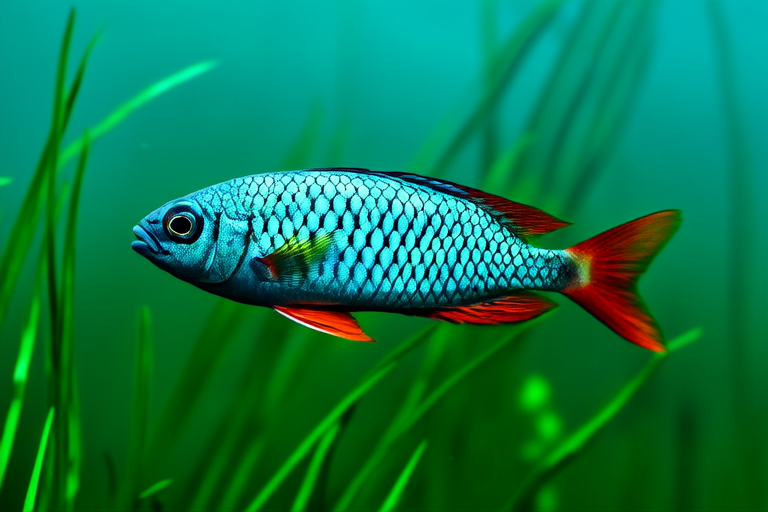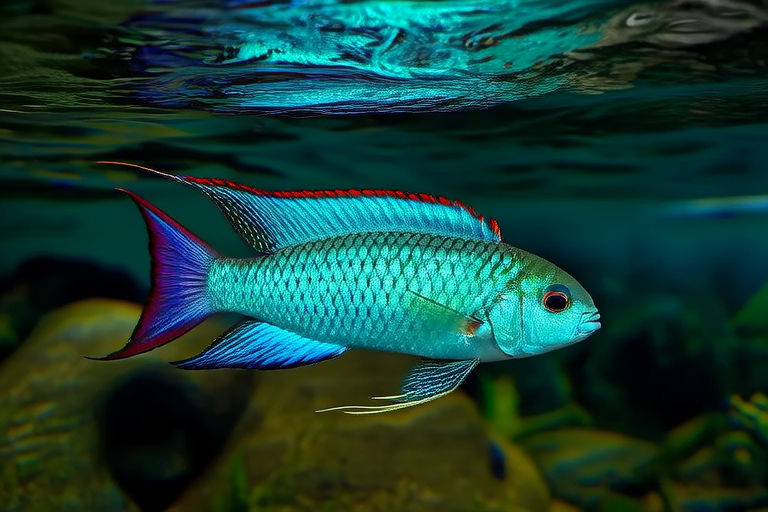
Rajah Cichlid Behavior Decoded: Understanding Their Unique Traits
The Rajah Cichlid (Vicary’s cichlid, Aequidens rivulatus) is a captivating species native to the Amazon Basin, particularly in Peru and Brazil. This freshwater fish is renowned for its striking appearance, characterized by a vibrant green body adorned with electric blue spots and a distinct red tail. The male Rajah Cichlid is typically larger and more colorful than the female, with a pronounced hump on its forehead that develops as it matures. These features make them a popular choice among aquarists seeking both aesthetic appeal and interactive companions.
Natural Habitat and Its Influence on Behavior
Native to the slow-moving waters of the Amazon River basin, Rajah Cichlids thrive in environments rich with vegetation, submerged roots, and rocky structures. These habitats provide ample hiding spots and breeding territories, essential for their survival. In the wild, they exhibit territorial behavior, defending their chosen areas against intruders. This territoriality is a direct result of the limited space and resources available in their natural habitat, which has shaped their behavior over millennia. Understanding this context is crucial for aquarium owners aiming to replicate their natural environment, thereby promoting healthy and natural behaviors.
Social Behaviors: Interactions Within Their Own Species and With Other Tank Inhabitants
Rajah Cichlids are generally solitary or live in small groups, displaying complex social behaviors within their species. They are known to be aggressive towards conspecifics, especially during breeding seasons. Males engage in elaborate displays, flaring their fins and chasing rivals away from their territory. Females may also display aggressive behaviors if they feel threatened or are competing for resources. When kept in a community tank, it’s important to choose compatible species that can coexist peacefully. Fish like the Angelfish or Silver Dollars are often recommended due to their similar temperaments and size. However, caution must be exercised to avoid overcrowding, which can exacerbate aggression.
Feeding Habits: Preferences and Peculiarities
Rajah Cichlids are omnivorous, feeding on a variety of foods in the wild, including insects, small crustaceans, plant matter, and algae. In captivity, they adapt well to commercial pellets and flakes, but it’s beneficial to supplement their diet with live or frozen foods such as brine shrimp, bloodworms, and daphnia to mimic their natural diet. Interestingly, they exhibit selective feeding behaviors, often preferring certain types of food over others. Observations have shown that they tend to consume smaller prey items first before moving on to larger ones. This behavior is thought to be an evolutionary adaptation to maximize energy efficiency. Ensuring a varied diet can help maintain their health and vitality.
Breeding Behaviors: Courtship Rituals and Parental Care
The breeding process of Rajah Cichlids is fascinating and involves intricate courtship rituals. During the mating season, males establish and defend breeding territories, displaying vibrant colors and engaging in elaborate dances to attract females. Once a pair is formed, they will clean a flat surface, such as a rock or the bottom of the tank, to deposit their eggs. The female lays several hundred eggs, which the male then fertilizes. Both parents take turns guarding the eggs and fanning them with their fins to ensure proper oxygenation. After hatching, the fry (young fish) remain under the protection of their parents for several weeks, during which time they are fed regurgitated food by the adults. This level of parental care underscores the importance of providing a safe and nurturing environment for breeding pairs.
Tips for Aquarium Owners
To ensure the well-being of Rajah Cichlids, it’s essential to create an environment that mimics their natural habitat. A spacious tank with plenty of hiding spots, such as caves and dense vegetation, is ideal. The water parameters should be maintained at a pH of 6.0 to 7.5, with temperatures between 74°F and 82°F. Regular water changes and filtration are crucial to maintaining water quality. Additionally, providing a varied diet and ensuring sufficient space for each fish can help minimize stress and promote healthy behavior. Engaging with your Rajah Cichlids through gentle interaction can also enhance their well-being, fostering a positive relationship between you and your aquatic companions.
Common Misconceptions and Insights
One common misconception about Rajah Cichlids is that they are overly aggressive and unsuitable for community tanks. While they can be territorial, careful selection of tankmates and proper setup can mitigate these issues. Another misconception is that they require minimal care. In reality, their unique needs demand attentive management to ensure optimal health and happiness. By understanding their behavior and addressing these misconceptions, aquarium owners can better appreciate and enjoy the presence of Rajah Cichlids in their homes. Scientific studies, such as those conducted by
In conclusion, the Rajah Cichlid is a species rich in character and complexity. From their striking appearance to their intricate social and breeding behaviors, these fish offer a rewarding experience for those willing to understand and meet their needs. By delving into their natural history and behavior, we can foster healthier, happier fish and enrich our own enjoyment of the hobby. Whether you’re a seasoned aquarist or a beginner, taking the time to learn about the unique traits of the Rajah Cichlid can greatly enhance your experience of owning these remarkable creatures.






